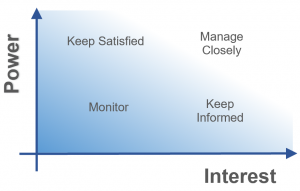
A Stakeholder Engagement Plan is a formal strategy to communicate with project stakeholders to achieve their support for the project.
It specifies the frequency and type of communications, media, contact persons, and locations of communication events. It is created at the beginning of the project and updated frequently as stakeholder communication needs change.
The Project Management Body of Knowledge (PMBOK) specifies the creation of a Stakeholder Engagement Plan as part of the Plan Stakeholder Engagement Process within the Project Stakeholder Management knowledge area.
Project Management Body of Knowledge, 6th Edition, 13.2.3.1
The stakeholder engagement plan is a component of the project management plan that identifies the strategies and actions required to promote productive involvement of stakeholders in decision making and execution. It can be formal or informal and highly detailed or broadly framed, based on the needs of the project and the expectations of stakeholders.
Parts of a Stakeholder Engagement Plan
A good stakeholder engagement plan contains the following parts:
- Stakeholder list
The first step in any stakeholder engagement plan is to list the stakeholders. But it’s important to be thorough because it’s easy to underestimate the ability of a minor stakeholder to trip up the project when they’re not being communicated with adequately. According to the PMBOK, this list is called a Stakeholder Register, and it is created as part of the Identify Stakeholders process. - Project phase
Many stakeholders will be involved in only a certain phase of the project. - Contact name(s)
It’s important to be in contact with the correct people. Large organizations or government (regulatory) stakeholders have many layers of bureaucracy which can result in project delays when the primary decision maker is not being communicated with directly. - Areas of Influence
This is where the stakeholder’s “stake” is defined. How do their interests overlap with the project? What are their business goals and how does your project interfere with them? Why is this stakeholder interested in your project? There can be no meaningful stakeholder engagement without understanding each other’s viewpoints. - Power
Each stakeholder has a unique ability to stop and/or change the project. What is that ability? Where does it derive from, and how can it be controlled? Sometimes the stakeholder’s power over the project can be removed, but this comes at a cost, both monetary and in stakeholder satisfaction (they could become very unhappy and influence other stakeholders). - Engagement approach
The strategy for engaging the stakeholder must be outlined in detail. The types and frequency of communication, for example weekly emails, monthly phone calls, or weekly face to face meetings. The content of those communications, for example a weekly update that contains project progress, design information, and open house plans.
How to Develop a Stakeholder Engagement Plan
There are five steps to developing a stakeholder engagement plan:
- Classify Stakeholders
As an initial step in stakeholder analysis, classifying the stakeholders into defined groups can assist in the next, more detailed steps. Stakeholders can be classified into supporting or opposed, for example a project investor is a supporter and an environmental NGO is opposed. They can be divided into Upwards/Sideways/Outwards/Downwards, for example, upwards are executives from the parent organization, sideways are project suppliers and contractors, outwards are other projects competing for limited resources and downwards are the project team, suppliers and contractors.  Develop Power/Interest Grid
Develop Power/Interest Grid
This is the primary stakeholder analysis tool. It contains the power of the stakeholder on the y-axis, which is the ability of the stakeholder to stop and/or change the project, and the interest level of the stakeholder on the x-axis, which is the amount of overlap the stakeholder’s interests have with the project. This defines the stakeholder’s “stake” in the project.- Define Power
Although the stakeholder’s location on the chart is important, a verbal analysis of the power of the stakeholder is imperative to get a sense of how much influence the stakeholder has. For example, a government regulatory agency usually has extremely high power to stop the project – they can withhold their approval and stop the project immediately. The success of the project is heavily dependent on keeping them informed on an ongoing basis. - Define Interest
Once again, the location of the stakeholder on the chart is expanded and analyzed to determine what their interest in the project really is. The stakeholder’s business interests are analyzed and prioritized. Their needs and wants are described to a point where the stakeholder is well understood by the project management team. - Develop the Stakeholder Engagement Plan
The stakeholder communication needs are itemized based on the power and influence analysis. The type of communication and its frequency is specified. The other parts of the stakeholder engagement plan, described above, are more administrative in nature.
Importance of Stakeholder Engagement
The stakeholder engagement plan is the foundation for achieving stakeholder buy-in for the project.
Of course, the plan must be tailored to the size of the project, as with all parts of the project management plan. For the smallest possible project, where one person writes a report for one project sponsor, a written stakeholder engagement plan is probably not necessary. But the concept is still present – the single stakeholder must be managed in order to achieve their buy-in.
For large projects, such as mining or infrastructure projects, stakeholder engagement is a major undertaking. The many stakeholders all have different needs and wants, and their power and interest in the project are all unique, requiring specialized consultation requirements. The stakeholder engagement plans are given to the project management team, and potentially the parent organization for approval prior to implementation. The plans are then put into action and the project management team are continuously updated regarding the the status of each stakeholder.
How to Improve Stakeholder Engagement
 For projects that need it, detailed stakeholder engagement plans are indispensable. But often the secret to project success is in the continuous improvement of the stakeholder consultation process rather than in rigid adherence to a plan. That is, there is a creative component rather than a purely analytical one.
For projects that need it, detailed stakeholder engagement plans are indispensable. But often the secret to project success is in the continuous improvement of the stakeholder consultation process rather than in rigid adherence to a plan. That is, there is a creative component rather than a purely analytical one.
In that spirit, I will outline the following three steps to improve stakeholder engagement for all projects:
- Show the stakeholder you care
Stakeholders understand that someone wants to win them over, and that the organization probably has a plan to do just that. Believe me, there are many, many projects out there where organizations have engaged stakeholders with an aggressive, empathy-free attitude attempting to strong arm the stakeholder into project approval. This tends to drive stakeholders further into their trenches and develop their opposition. Even if you have the power to stop their concerns, they often exercise their right to spread bad word of mouth, which takes enormous amounts of time and money to neutralize. A little bit of empathy costs nothing, but accomplishes great strides in addressing project opposition. - Emphasize the human aspect
Private sector projects are undertaken by organizations that hope to enhance their bottom line, to increase their profits. Government and NGO projects also have goals that sometimes overlap with stakeholders with conflicting interests. But it’s not only about the money. Even private sector projects have a societal benefit – the employment of the project staff, that is, the project is a crucial piece in the generation of prosperity to society. In other words, there are people on both sides. Project stakeholders should be consulted in a way that communicates the benefits to society rather than purely increasing investor profits. Of course, some projects might be structured so as to be excessively profit driven at someone else’s expense, in which case the project management team needs to ask themselves if they need to change their plan. - Give stakeholders a voice
More than anything else, people want to be heard. It’s amazing what type of transformation takes place when a stakeholder is allowed to voice their concerns and realizes that it’s being heard. But therein lies the rub. Most stakeholders are well attuned to the possibility that they will be listened to and ignored. The transformation occurs when they truly believe that the project management team has considered their concerns and tried very hard to implement them. And this belief is not accomplished by the development and rigid implementation of a plan.






